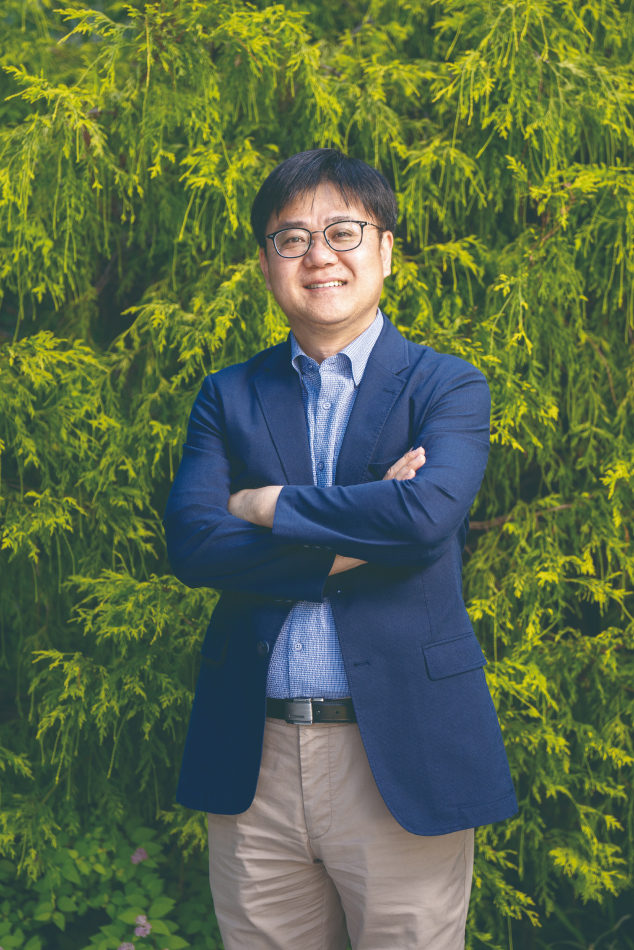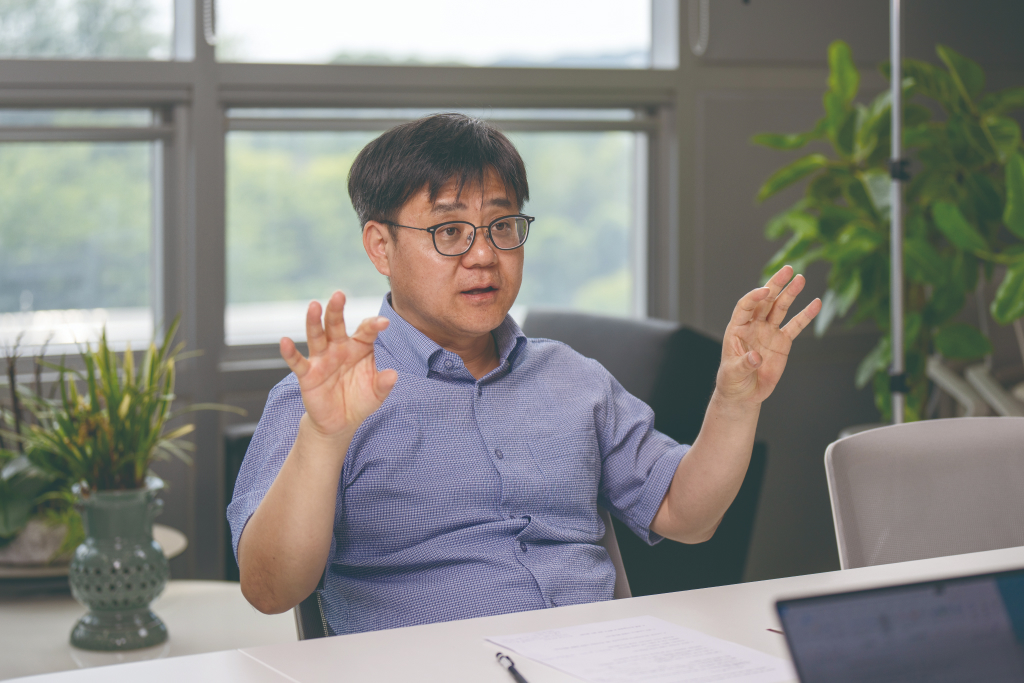주메뉴
- About IBS 연구원소개
-
Research Centers
연구단소개
- Research Outcomes
- Mathematics
- Physics
- Center for Underground Physics
- Center for Theoretical Physics of the Universe (Particle Theory and Cosmology Group)
- Center for Theoretical Physics of the Universe (Cosmology, Gravity and Astroparticle Physics Group)
- Dark Matter Axion Group
- Center for Artificial Low Dimensional Electronic Systems
- Center for Quantum Nanoscience
- Center for Exotic Nuclear Studies
- Center for Van der Waals Quantum Solids
- Center for Relativistic Laser Science
- Chemistry
- Life Sciences
- Earth Science
- Interdisciplinary
- Center for Neuroscience Imaging Research (Neuro Technology Group)
- Center for Neuroscience Imaging Research (Cognitive and Computational Neuroscience Group)
- Center for Algorithmic and Robotized Synthesis
- Center for Nanomedicine
- Center for Biomolecular and Cellular Structure
- Center for 2D Quantum Heterostructures
- Institutes
- Korea Virus Research Institute
- News Center 뉴스 센터
- Career 인재초빙
- Living in Korea IBS School-UST
- IBS School 윤리경영


주메뉴
- About IBS
-
Research Centers
- Research Outcomes
- Mathematics
- Physics
- Center for Underground Physics
- Center for Theoretical Physics of the Universe (Particle Theory and Cosmology Group)
- Center for Theoretical Physics of the Universe (Cosmology, Gravity and Astroparticle Physics Group)
- Dark Matter Axion Group
- Center for Artificial Low Dimensional Electronic Systems
- Center for Quantum Nanoscience
- Center for Exotic Nuclear Studies
- Center for Van der Waals Quantum Solids
- Center for Relativistic Laser Science
- Chemistry
- Life Sciences
- Earth Science
- Interdisciplinary
- Center for Neuroscience Imaging Research (Neuro Technology Group)
- Center for Neuroscience Imaging Research (Cognitive and Computational Neuroscience Group)
- Center for Algorithmic and Robotized Synthesis
- Center for Nanomedicine
- Center for Biomolecular and Cellular Structure
- Center for 2D Quantum Heterostructures
- Institutes
- Korea Virus Research Institute
- News Center
- Career
- Living in Korea
- IBS School
News Center
| Title | "Good papers aren’t enough; "meaningful" research is what I'm after." | ||||
|---|---|---|---|---|---|
| Name | 전체관리자 | Registration Date | 2024-09-13 | Hits | 2185 |
| att. |
 Director SHIN Hyeon Suk, Center for 2D Quantum Heterostructures.jpg
Director SHIN Hyeon Suk, Center for 2D Quantum Heterostructures.jpg
|
||||
Director SHIN Hyeon Suk, Center for 2D Quantum Heterostructures "Good papers aren’t enough; "meaningful" research is what I'm after." In late May, with the summer approaching, I met Director SHIN Hyeon Suk of the Center for 2D Quantum Heterostructures in N Center at Sungkyunkwan University. Director Shin has been developing innovative materials for the miniaturization of next-generation semiconductors and was appointed as the director of the new IBS research center, Center for 2D Quantum Heterostructures. I decided on the first question of the interview just by looking at the name of the Center. Studying 2D materials showing quantum phenomenon
This must have been a popular question, as Director Shin used two name cards on his desk to explain. The two name cards with different designs each imply two different 2D structures. A 2D structure can be explained with graphene, an already well-known material. Graphene became known to the public in 2004, when Professor Andre GEIM of Manchester University, UK, first separated it from graphite using cellophane tape. The structure consists of a single layer of atoms, in which carbon atoms are arranged horizontally in a hexagonal honeycomb shape without additional vertical structure. As such, it is as thin as a single carbon atom. Director Shin compared one name card to the graphene, and the other to hexagonal Boron Nitride (hBN). The 2D structure has a rather short history. In addition to graphene and hexagonal boron nitride, transition metal dichalcogenides, black phosphorous, and MXenes are known to be 2d structures. Their characteristics and what happens when changes are applied to these structures are now being revealed, little by little. "I first established my own independent lab when I came to UNIST in 2008. As I kept doing research, I thought that I should do something that others don't do. Back then, other 2D materials besides graphene did not receive enough attention. I researched transition metal dichalcogenides and hexagonal boron nitride. It was exciting to work in a less explored field, and the results were rewarding. I began studying hexagonal boron nitride in earnest around 2012, and published the first article in 2013." In 2016, after the team at the University of Technology Sydney in Australia discovered that single photons are emitted from defects in hBN, the interest in quantum light sources from 2D structures began to grow. Director Shin's research on large-area synthesis and properties of hBN also received attention. "There are some representative research teams that study applications of the hBN for quantum light source: the University of Technology Sydney, which first discovered single photon emission, and the University of Cambridge in the UK. We're not competing against each other; our focuses are slightly different, so we are collaborating. For example, when we synthesize a new structure, the University of Cambridge team asks for some samples to study its properties. We are working together for a better result."
The goal is to study the life cycle of 2D materials
IBS is a research organization that brought the basic science of Korea to the highest level in the world. Any scientist, regardless of nationality, who is considered top of the field is appointed as director. Because directors are guaranteed autonomy in research, they must have a good plan on how to run the research center. Director Shin is also building his plans for his own center. "Quantum technology is considered to be the field that will be crucial for humanity's future, and it is being actively researched even now. Diverse quantum materials are being explored, with most of such research focusing on 3D materials such as the diamond. The goal of my research center is to find a 2D structure that exhibits quantum phenomena." Director Shin stated that the goal of the center is to study the 'life cycle of 2D materials.' He plans to build 2D materials that show quantum phenomena and develop technology to utilize these materials in quantum information technology. The first step is to conceive and design the precursor of the 2D materials that exhibit quantum phenomena. The precursor is the starting material for creating synthetic material. To make graphene oxide, graphite oxide must be made first. Before that, graphite oxide is made from graphite. Thus, graphite is the precursor for graphene oxide. To make a new material that does not exist in nature, it is necessary to create the precursor first. "It is also important to create the 2D structure based on the precursor in a large area. In order to utilize this material in quantum information technology, lithography must be possible in the semiconductor." In semiconductor manufacturing, larger silicon substrates offer significant advantages. With a large substrate, more chips can be manufactured in a single batch. The same goes for quantum information technology. To scale up quantum materials, technology that synthesizes them in large areas is crucial. A thin, flexible 2D material is even more valuable. Director Shin sees that the 2D material can become the key to quantum information technology, specifically as a single photon emitter (quantum emitter). To use photons in quantum information technology, the photons must be released one by one. In a generic light source such as fluorescent light, photons are released in bulk; thus it is difficult to convey information using them. In quantum information technology, making a quantum light source that emits individual photons is key. "When we reach this stage, we'll use this to create a quantum photonic integrated circuit, like the semiconductor photonic integrated circuit. Reaching this stage would mean that we are really ready to introduce this technology to the industry. Of course, economic feasibility and compatibility with other technology must be taken into consideration."
Research must contribute to the technology of the society 20, 30 years into the future "A university president that I worked with in the past asked me what I'd do after I write my Nature and Science articles. When I was a student, or a new researcher fresh out of school, my goal was to write good papers and publish them in high impact factor journals. As my publication records grew as a researcher, that question still lingered in my mind." Director Shin emphasized that even research that started from basic science should be used in society in the future. The cutting-edge technologies that drive modern society started 20-30 years ago in the basic sciences before commercialization. The basic science of the 1930s that studied the electrical characteristics of silicon led to the founding of Intel in the 1960s. "I hope that the IBS's research will contribute to the society 10, 20 years from now. I really want my research to be one of such." he first step for this goal is to recruit members of the research center. Director Shin is putting most of his efforts into this. I asked him what kind of researcher he wanted to work with. Director Shin's biggest emphasis is on 'open-mindedness.' This is a mandatory virtue in any multidisciplinary research that requires a lot of collaboration. "Any researcher coming to the IBS will have plenty of qualifications. I want someone who can pay attention to others' opinions, even if that hinders things in the short term. With such a team, I want to work hard so that 10 years later, when someone asks, 'Who's the leading expert in 2D structure or quantum light source?’ everyone answers, ‘the SHIN Hyeon Suk team of IBS in Korea.’” |
|||||
| Next | |
|---|---|
| before |
- Content Manager
- Public Relations Team : Yim Ji Yeob 042-878-8173
- Last Update 2023-11-28 14:20













